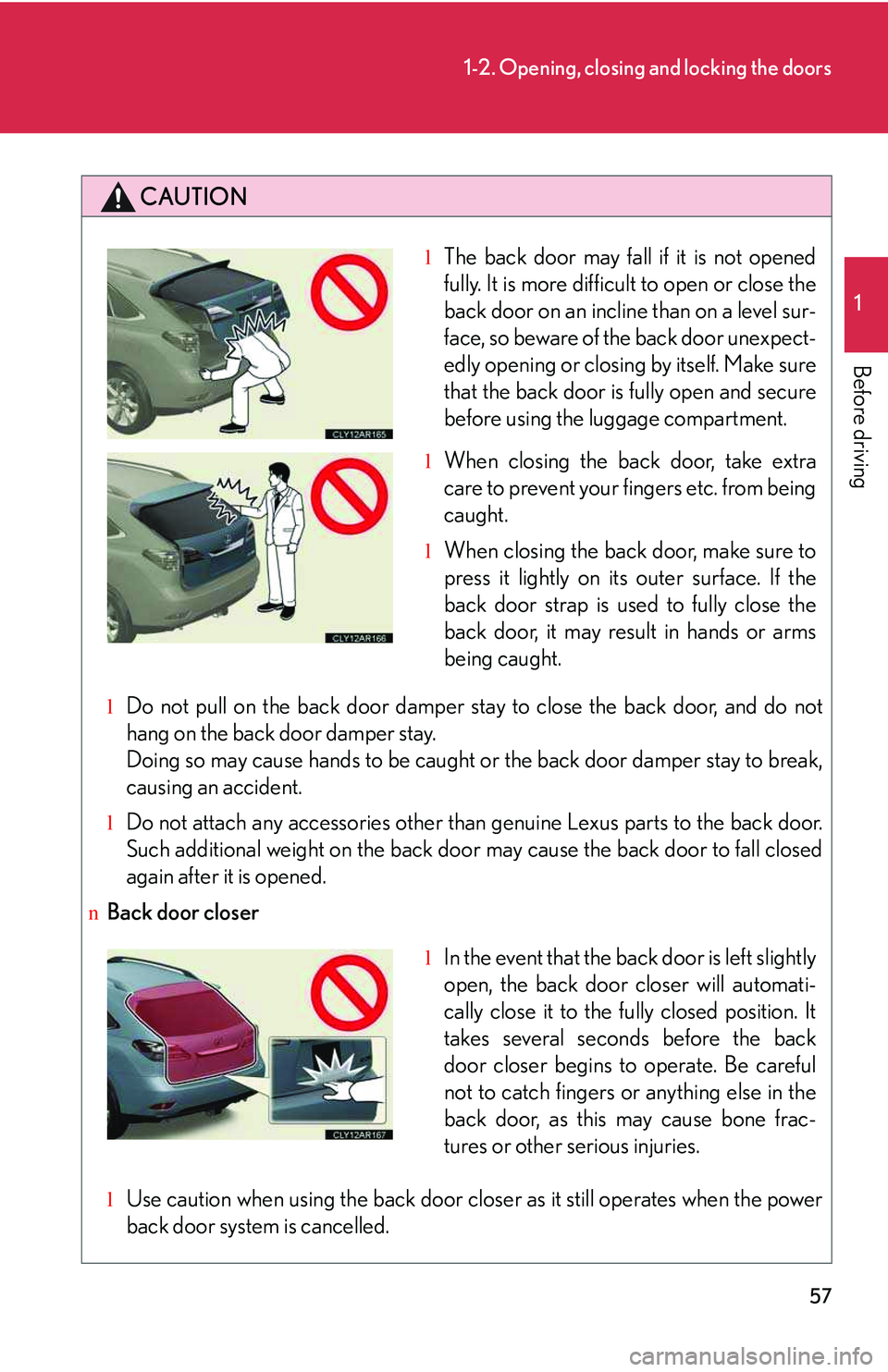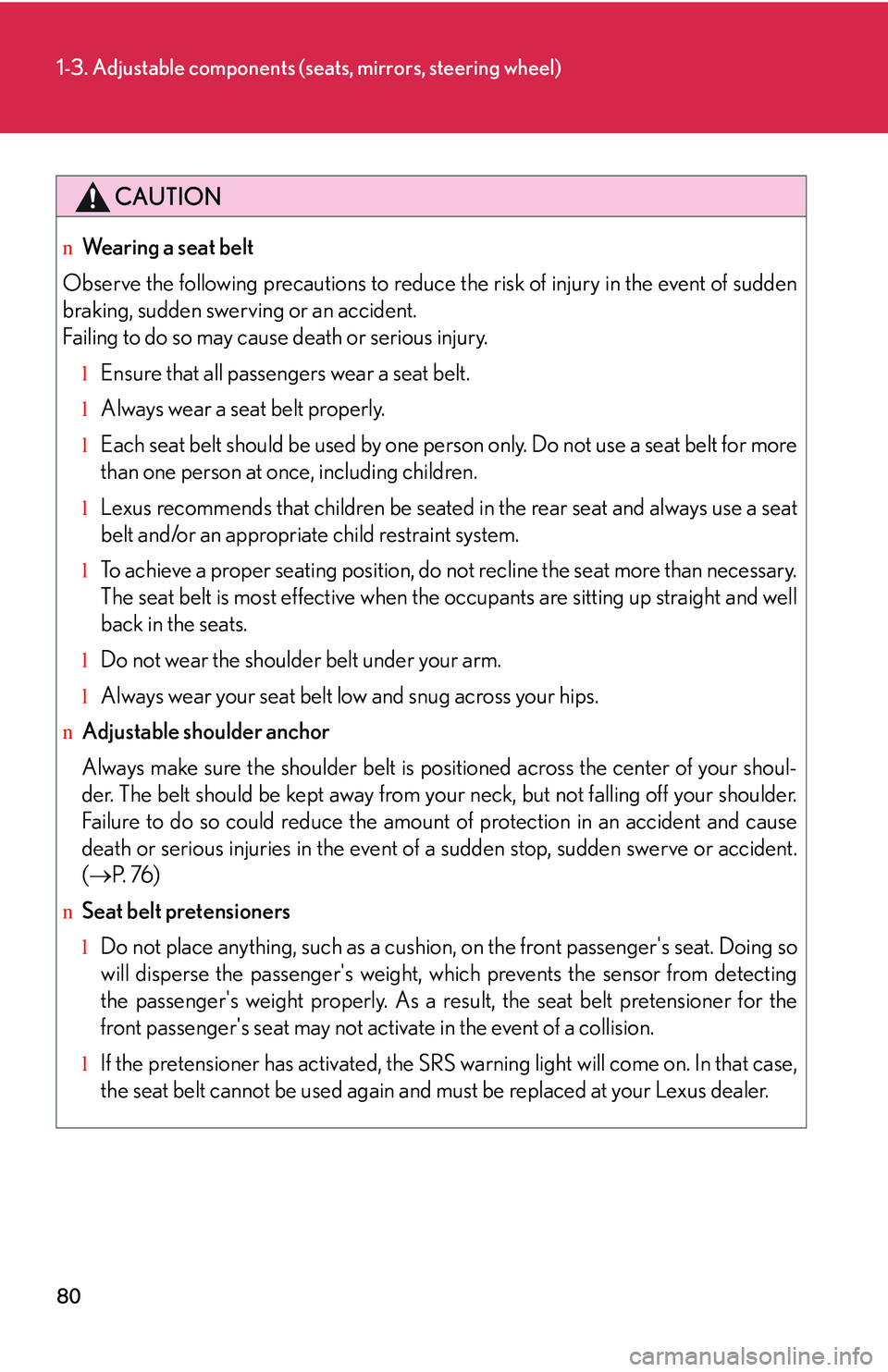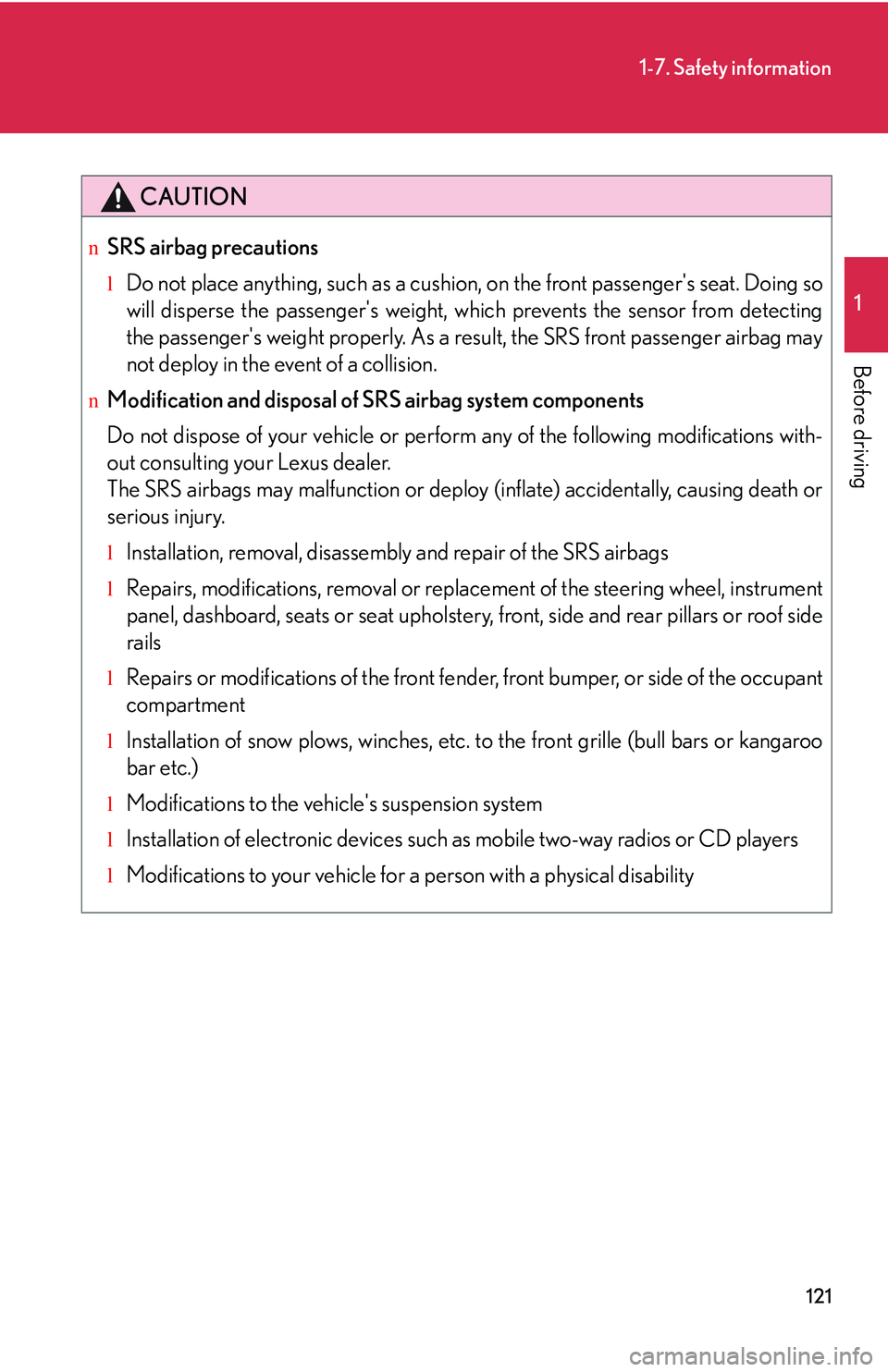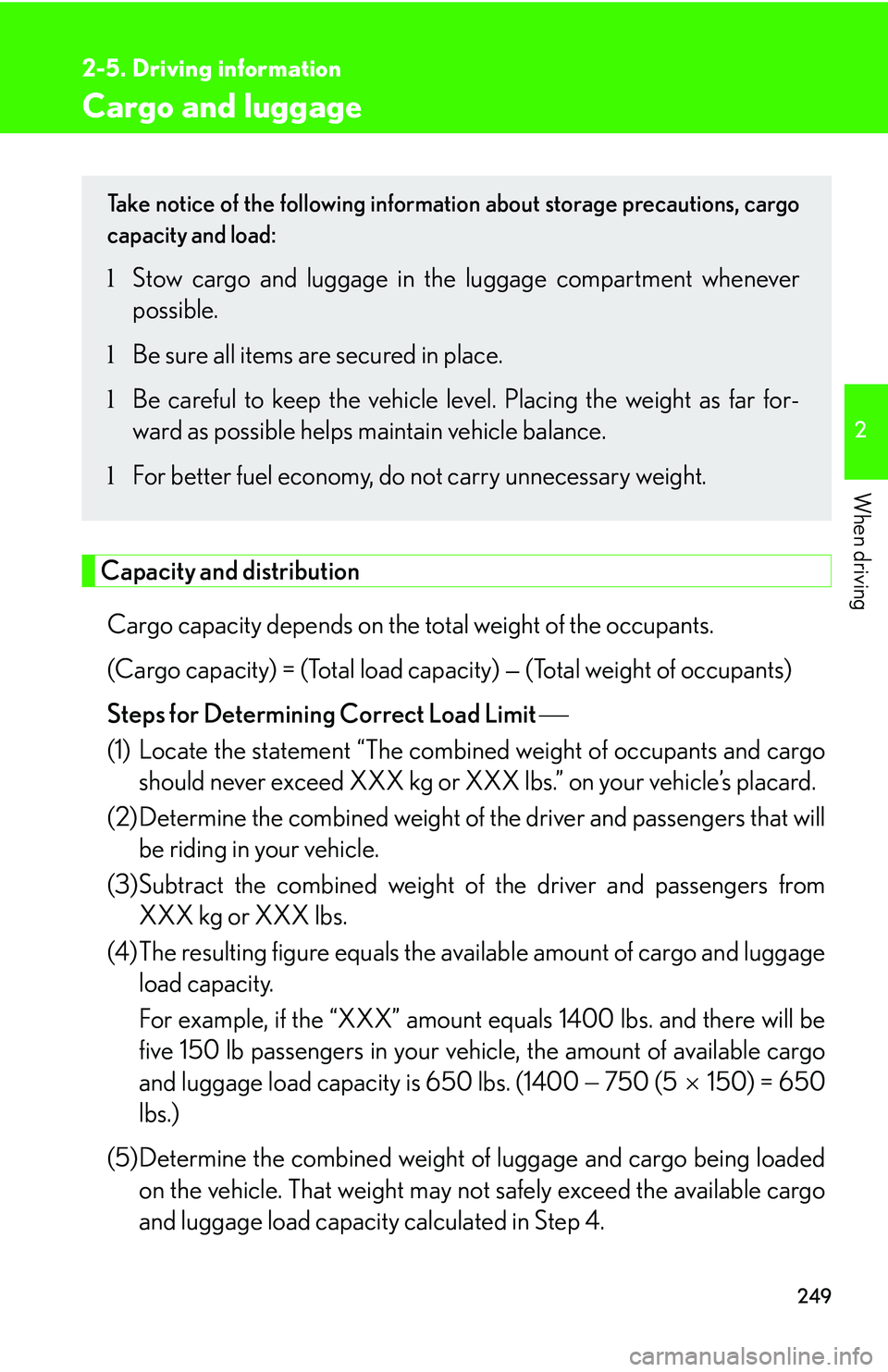weight LEXUS RX350 2011 Owners Manual
[x] Cancel search | Manufacturer: LEXUS, Model Year: 2011, Model line: RX350, Model: LEXUS RX350 2011Pages: 821, PDF Size: 13.27 MB
Page 130 of 821

57
1-2. Opening, closing and locking the doors
1
Before driving
CAUTION
lDo not pull on the back door damper stay to close the back door, and do not
hang on the back door damper stay.
Doing so may cause hands to be caught or the back door damper stay to break,
causing an accident.
lDo not attach any accessories other than genuine Lexus parts to the back door.
Such additional weight on the back door may cause the back door to fall closed
again after it is opened.
nBack door closer
lUse caution when using the back door closer as it still operates when the power
back door system is cancelled.
lThe back door may fall if it is not opened
fully. It is more difficult to open or close the
back door on an incline than on a level sur-
face, so beware of the back door unexpect-
edly opening or closing by itself. Make sure
that the back door is fully open and secure
before using the luggage compartment.
lWhen closing the back door, take extra
care to prevent your fingers etc. from being
caught.
lWhen closing the back door, make sure to
press it lightly on its outer surface. If the
back door strap is used to fully close the
back door, it may result in hands or arms
being caught.
lIn the event that the back door is left slightly
open, the back door closer will automati-
cally close it to the fully closed position. It
takes several seconds before the back
door closer begins to operate. Be careful
not to catch fingers or anything else in the
back door, as this may cause bone frac-
tures or other serious injuries.
Page 153 of 821

80
1-3. Adjustable components (seats, mirrors, steering wheel)
CAUTION
nWearing a seat belt
Observe the following precautions to reduce the risk of injury in the event of sudden
braking, sudden swerving or an accident.
Failing to do so may cause death or serious injury.
lEnsure that all passengers wear a seat belt.
lAlways wear a seat belt properly.
lEach seat belt should be used by one person only. Do not use a seat belt for more
than one person at once, including children.
lLexus recommends that children be seated in the rear seat and always use a seat
belt and/or an appropriate child restraint system.
lTo achieve a proper seating position, do not recline the seat more than necessary.
The seat belt is most effective when the occupants are sitting up straight and well
back in the seats.
lDo not wear the shoulder belt under your arm.
lAlways wear your seat belt low and snug across your hips.
nAdjustable shoulder anchor
Always make sure the shoulder belt is positioned across the center of your shoul-
der. The belt should be kept away from your neck, but not falling off your shoulder.
Failure to do so could reduce the amount of protection in an accident and cause
death or serious injuries in the event of a sudden stop, sudden swerve or accident.
(�→P. 76 )
nSeat belt pretensioners
lDo not place anything, such as a cushion, on the front passenger's seat. Doing so
will disperse the passenger's weight, which prevents the sensor from detecting
the passenger's weight properly. As a result, the seat belt pretensioner for the
front passenger's seat may not activate in the event of a collision.
lIf the pretensioner has activated, the SRS warning light will come on. In that case,
the seat belt cannot be used again and must be replaced at your Lexus dealer.
Page 194 of 821

121
1-7. Safety information
1
Before driving
CAUTION
nSRS airbag precautions
lDo not place anything, such as a cushion, on the front passenger's seat. Doing so
will disperse the passenger's weight, which prevents the sensor from detecting
the passenger's weight properly. As a result, the SRS front passenger airbag may
not deploy in the event of a collision.
nModification and disposal of SRS airbag system components
Do not dispose of your vehicle or perform any of the following modifications with-
out consulting your Lexus dealer.
The SRS airbags may malfunction or deploy (inflate) accidentally, causing death or
serious injury.
lInstallation, removal, disassembly and repair of the SRS airbags
lRepairs, modifications, removal or replacement of the steering wheel, instrument
panel, dashboard, seats or seat upholstery, front, side and rear pillars or roof side
rails
lRepairs or modifications of the front fender, front bumper, or side of the occupant
compartment
lInstallation of snow plows, winches, etc. to the front grille (bull bars or kangaroo
bar etc.)
lModifications to the vehicle's suspension system
lInstallation of electronic devices such as mobile two-way radios or CD players
lModifications to your vehicle for a person with a physical disability
Page 198 of 821

125
1-7. Safety information
1
Before driving
*4: Never install a rear-facing child restraint system on the front passen-
ger seat. A forward-facing child restraint system should only be
installed on the front passenger seat when it is unavoidable.
(�→P. 127)
*5: In case indicator light is not illuminated, consult this manual on how to
install the child restraint system properly. (�→P. 131)
CAUTION
nFront passenger occupant classification system precautions
Observe the following precautions regarding the front passenger occupant classifi-
cation system.
Failure to do so may cause death or serious injury.
lWear the seat belt properly.
lMake sure the front passenger’s seat belt tab has not been left inserted into the
buckle before someone sits in the front passenger seat.
lMake sure the “AIR BAG OFF” indicator light is not illuminated when using the
seat belt extender for the front passenger seat. If the “AIR BAG OFF” indicator
light is illuminated, disconnect the extender tongue from the seat belt buckle,
then reconnect the seat belt. Reconnect the seat belt extender after making sure
the “AIR BAG ON” indicator light is illuminated. If you use the seat belt extender
while the “AIR BAG OFF” indicator light is illuminated, the front passenger air-
bag, side airbag on the front passenger side and front passenger knee airbag may
not activate correctly, which could cause death or serious injury in the event of
collision.
lDo not apply a heavy load to the front passenger seat or equipment.
lDo not put weight on the front passenger seat by putting your hands or feet on
the front passenger seat seatback from the rear passenger seat.
lDo not let a rear passenger lift the front passenger seat with their feet or press on
the seatback with their legs.
lDo not put objects under the front passenger seat.
Page 321 of 821

249
2-5. Driving information
2
When driving
Cargo and luggage
Capacity and distribution
Cargo capacity depends on the total weight of the occupants.
(Cargo capacity) = (Total load capacity) — (Total weight of occupants)
Steps for Determining Correct Load Limit �⎯
(1) Locate the statement “The combined weight of occupants and cargo
should never exceed XXX kg or XXX lbs.” on your vehicle’s placard.
(2) Determine the combined weight of the driver and passengers that will
be riding in your vehicle.
(3)Subtract the combined weight of the driver and passengers from
XXX kg or XXX lbs.
(4)The resulting figure equals the available amount of cargo and luggage
load capacity.
For example, if the “XXX” amount equals 1400 lbs. and there will be
five 150 lb passengers in your vehicle, the amount of available cargo
and luggage load capacity is 650 lbs. (1400 �− 750 (5� �×� 150) = 650
lbs.)
(5)Determine the combined weight of luggage and cargo being loaded
on the vehicle. That weight may not safely exceed the available cargo
and luggage load capacity calculated in Step 4.
Take notice of the following information about storage precautions, cargo
capacity and load:
lStow cargo and luggage in the luggage compartment whenever
possible.
lBe sure all items are secured in place.
lBe careful to keep the vehicle level. Placing the weight as far for-
ward as possible helps maintain vehicle balance.
lFor better fuel economy, do not carry unnecessary weight.
Page 322 of 821

250
2-5. Driving information
(6)If your vehicle will be towing a trailer, load from your trailer will be
transferred to your vehicle. Consult this manual to determine how this
reduces the available cargo and luggage load capacity of your vehi-
cle.
(�→P. 5 9 4 )
Example based on your vehicle
Cargo capacity
Total load capacity
When 2 people with the combined weight of 366 lb. (166 kg) are riding
in your vehicle, which has a total load capacity of 885 lb. (400 kg), the
available amount of cargo and luggage load capacity will be as follows:
885 lb. — 366 lb. = 519 lb. (400 kg —166 kg = 234 kg)
In this condition, if 3 more passengers with the combined weight of 388 lb.
(176 kg) get on, the available cargo and luggage load will be reduced as fol-
lows:
519 lb. — 388 lb. = 131 lb. (234 kg — 176 kg = 58 kg)
As shown in the example above, if the number of occupants increases,
the cargo and luggage load will be reduced by an amount that equals the
increased weight due to the additional occupants. In other words, if an
increase in the number of occupants causes an excess of the total load
capacity (combined weight of occupants plus cargo and luggage load),
you must reduce the cargo and luggage on your vehicle.
Page 324 of 821

252
2-5. Driving information
CAUTION
nRoof luggage carrier precautions
To use the roof rails as a roof luggage carrier, you must fit the roof rails with two or
more genuine Lexus cross rails or their equivalent.
When you load cargo on the roof luggage carrier, observe the following:
lBefore driving, make sure the cargo is securely fastened on the roof luggage car-
rier.
lLoading cargo on the roof luggage carrier will make the center of gravity of the
vehicle higher. Avoid high speeds, sudden starts, sharp turns, sudden braking or
abrupt maneuvers, otherwise the result may be a loss of control or vehicle roll-
over due to failure to operate this vehicle correctly and result in death or serious
injury.
lIf driving for a long distances, on rough roads, or at high speeds, stop the vehicle
now and then during the trip to make sure the cargo remains in its place.
lDo not exceed 165 lb. (75 kg) cargo weight on the roof luggage carrier.
lTo reduce wind noise when there is no luggage loaded on the roof luggage car-
rier, move the front cross rail to the front-most position and the rear cross rail to
the rearmost position.
NOTICE
nWhen loading cargo
Be careful not to scratch the surface of the moon roof.
lPlace the cargo so that its weight is distrib-
uted evenly between the front and rear
axles.
lIf loading long or wide cargo, never exceed
the vehicle’s overall length or width.
(�→P. 5 9 4 )
Cross rails
Roof rails
Page 325 of 821

253
2-5. Driving information
2
When driving
Vehicle load limits
nTotal load capacity and seating capacity
These details are also described on the tire and loading information label.
(�→P. 4 8 7 )
CAUTION
nOverloading the vehicle
Do not overload the vehicle.
It may not only cause damage to the tires, but also degrade steering and braking
ability, resulting in an accident.
Vehicle load limits include total load capacity, seating capacity, towing
capacity and cargo capacity.
nTotal load capacity: 885 lb. (400 kg)
Total load capacity means the combined weight of occupants, cargo and
luggage.
nSeating capacity: 5 occupants (Front 2, Rear 3)
Seating capacity means the maximum number of occupants whose esti-
mated average weight is 150 lb. (68 kg) per person.
nTowing capacity
Without a towing package: 2000 lb. (907 kg)
With a towing package: 3500 lb. (1588 kg)
Towing capacity means the maximum gross trailer weight (trailer weight
plus its cargo weight) that your vehicle is able to tow.
nCargo capacity
Cargo capacity may increase or decrease depending on the weight and
the number of occupants.
Page 331 of 821

259
2-5. Driving information
2
When driving
Weight limits
Confirm that the gross trailer weight, gross vehicle weight, gross axle
weight and trailer tongue load are all within the limits.
lThe gross trailer weight must never exceed the following:
Without towing package: 2000 lb. (907 kg)
With towing package: 3500 lb. (1588 kg)
lThe gross combined weight must never exceed the following:
Without towing package
2WD: 7560 lb. (3429 kg)
AWD: 7650 lb. (3470 kg)
With towing package
2WD: 9060 lb. (4109 kg)
AWD: 9150 lb. (4150 kg)
lThe gross vehicle weight must
never exceed the GVWR indi-
cated the Certification Label.
lThe gross axle weight on each
axle must never exceed the
GAWR indicated the Certifica-
tion Label.
Page 332 of 821

260
2-5. Driving information
Towing related term
Towing related termMeaning
GVWR (Gross Vehicle
Weight Rating)
The maximum allowable gross vehicle
weight. The gross vehicle weight is the total
weight of the vehicle. When towing a trailer,
it is the sum of the vehicle weight (including
the occupants, cargo and any optional
equipment installed on the vehicle) and the
tongue load.
GAWR (Gross Axle Weight
Rating)
The maximum allowable gross axle weight.
The gross axle weight is the load placed on
each axle (front and rear).
GCWR (Gross Combina-
tion Weight Rating)
The maximum allowable gross combination
weight. The gross combination weight is the
sum of the total vehicle weight (including
the occupants, cargo and any optional
equipment installed on the vehicle) and the
weight of the trailer being towed (including
the cargo in the trailer).
Gross trailer weightThe sum of the trailer weight and the weight
of the cargo in the trailer
Towing capacity
The maximum allowable gross trailer
weight. Towing capacity is calculated con-
sidering the base vehicle with necessary
vehicle equipment and occupants. Addi-
tional optional equipment, passengers and
cargo in the vehicle will reduce the towing
capacity, gross trailer weight include the
trailer, cargo and necessary equipment for
towing.
Tongue loadThe load placed on the trailer hitch ball